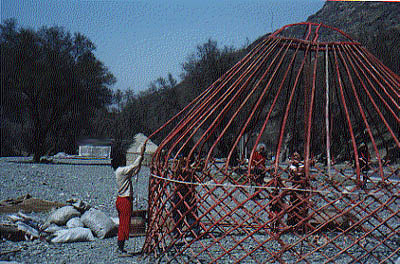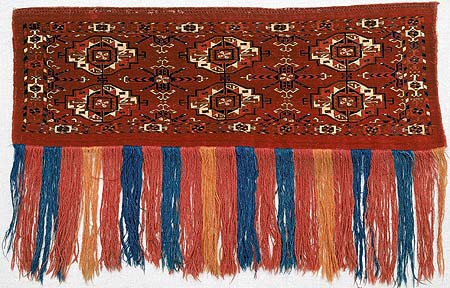|
Nomads were, and still are, dependent economically and physically
on their herds of animals. For transport, they relied primarily
on horses and camels. As a result, camels, and horses in
particular, were highly valued. This is 'reflected in the
wonderful array of woven and embroidered decorative trappings
used to ornament the animals – shaped blankets and
saddle covers, flank trappings, head and rump harnesses,
knee pads and, for Turkmen horses, special silver and carnelian-studded
leather horse jewellery.' (Sumner, 1999:28)
Herds
The only way for people to survive in this arid region was
to move with their herds of sheep and goats from place to
place each season. This became possible in the third millennium
BC when nomads began to use horses as transport, and importantly
they learned to ride horses. Camels were also used for transport,
and herds of sheep and goats grazed and moved with the nomads
on their seasonal travels to find good grazing. Sheep and
goats provided both food and drink and wool for clothes,
rugs, wall hangings and furnishings.
It
has been estimated that each nomadic family unit needed
about 100 kilograms of wool a year to make their own
clothing and felts, which is roughly equivalent to a
hundred large, thick woollen sweaters. (Sumner, 1999:24)
This website has been archived and is no longer updated.The content featured is no longer current and is being made available to the general public for research and historical information purposes only.
|
|
Photo:
Julie King
|
Yurts
In addition to horses and camels, portable homes (the felt
yurt) were vital to the nomadic lifestyle. The yurt allowed
the nomads to survive in very cold weather. This portable
lifestyle meant that art and creativity were expressed in
the rugs, furnishings and clothes which were also portable.
Setting
up and transporting the yurt
The yurt consisted of between five and eight sections of
willow-wood lattice tied together to form a circular frame.
A space was allowed for a doorway, which traditionally faced
east. More wooden slats locked into a small, circular frame
at the top to form the roof. This allowed the yurt to be
collapsed, transported and set up with ease. Women could
set up a yurt completely in just two to three hours. Three
camels were needed to transport the yurt and the family's
household possessions.
 |
|
Photo:
Adrienne Cobby
|
Textile
products for the yurt
A broad woven band was tied round the middle of the yurt
to stabilise it. For special occasions, such as weddings,
ceremonial bands were brought out and wound around the yurt.
Thick, shaped felts held with woven ropes formed the outer
walls and roof. The inner walls were made from woven reeds
or lined with printed cottons. The ground inside was covered
with felts; pile carpets and flat-woven rugs (kilims)
which featured beautiful patterns and rich earthy colours
were placed on top.
 |
|
Photo:
Adrienne Cobby
|
Areas
inside the yurt
The yurt was divided into areas for cooking and living.
The cooking area of the yurt was on the right and was considered
to be the women's area. The men's area was to the left and
often housed the riding equipment. If the household was
more affluent they may have had separate yurts for cooking,
producing rugs and entertaining visitors.
 |
|
Photo:
Adrienne Cobby
|
Household
goods were stored in carved wooden boxes or woven bags (juval,
torba etc.) strapped to the lattice. See Fig. 2 Tekke Turkmen
torba.

Fig
2. Tekke Turkmen torba
Small
bags like this were suspended from the wall of the nomads'
yurt (tent) and used to store household items. The major
(large) gul, geometric motif, is of a type often seen
on Tekke torbas, while the minor (small) gul occurs
in different forms in a range of weavings.
Wool warp and weft, wool and silk, asymmetrical knots,
made in north-western Afghanistan, about 1900. 1520
x 1030 mm. Powerhouse
Museum Collection 96/391/1,
purchased with the assistance of the Oriental Rug Society
of NSW, 1996. |
Clothing
The everyday clothes of the nomads were functional and attractive.
Their ceremonial dress in particular is noted for its beauty.
…
the densely embroidered chyrpys (silk coats) with long
false sleeves worked by Tekke Turkmen women until the
early 1900s… had different coloured ground cloth
depending on the age and marital status of the woman
wearing them and were worn for special festivals. They
are still made, but without the false sleeves and with
less embroidery. (Sumner, 1999:28)
Survival
of the nomads
To survive as nomads groups needed:
- safe
routes
- good
grazing land
- a
ready supply of water
- sufficient
wealth to own the necessary equipment.
However,
even with all this, nomads were subject to the extremes
of weather, the violence of other tribes and the threat
of wild animals. Life as a nomad could be far from idyllic.
From
the initial domestication of the horse as a riding animal
to the Manchu conquest of China in 1644 CE, the nomads
of Central Asia have interacted, often violently, with
the cultures that surround them. The first wave out
of the Caucasus, the Indo-Europeans, set the pattern
of raids, invasion, settlement and eventual blending
into the local civilisation. (Sumner, 1999:10)
Often
this resulted in nomads moving to more fertile land and
settling. Even so there were always plenty of other nomads
to take their place. 'Settlement demands order, control
and planning; nomadism requires flexibility, mobility and
opportunity.' (O'Bannon, 1998: 10)
The
interdependence of nomads and oasis dwellers
Although at times there was conflict between the nomads
and oasis dwellers, the oasis cities relied on nomads for
animals and animal products such as wool, leather and meat.
The nomads depended on the oasis dweller for agricultural
food products, silk and cotton threads, textiles and the
products of craft workshops: metalwork, woodwork and ceramics.
During
times of relative peace and prosperity, direct trade
also took place between the nomads and the major civilisations:
Greece, China, Iran, Byzantium. At annual border-town
fairs luxury items, tools, household goods and agricultural
products could be exchanged for fine horses and furs,
wool and leatherwork and sometimes goods stolen in raids
on caravans or distant cities. Because of the breadth
of the nomad range, they acted as a means of transmitting
arts and ideas from the borders of China to the heart
of eastern Europe. (Sumner, 1999:11-12)
|